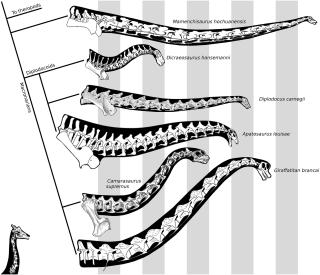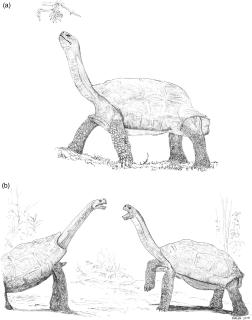Supplementary Information on sauropod neck sexual selection
15th May 2011
This page contains unofficial supplementary information for the
paper:
-
Taylor, Michael P.,
David W. E. Hone,
Mathew J. Wedel
and
Darren Naish.
2011.
The long necks of sauropods did not evolve primarily through
sexual selection.
Journal of Zoology,
Early View (Online Version of Record published before inclusion in
an issue).
doi: 10.1111/j.1469-7998.2011.00824.x
[PDF]
The following high-resolution versions of the figures from the
sauropod neck sexual selection paper are for the benefit of
scientists. Feel free to reproduce or modify these for use in
scientific (i.e. peer-reviewed) literature. Please do not
reproduce these in other non-scientific contexts without explicit
permission from the authors. (We'll proabably give permission, but
you need to check.)
|
Figure 1.
Sauropod necks, showing relationships for a selection of species, and
the range of necks lengths and morphologies that they encompass.
Phylogeny based on that of Upchurch et al. (2004: fig. 13.18).
Mamenchisaurus hochuanensis (neck 9.5 m long) modified from
Young & Zhao (1972: fig. 4); Dicraeosaurus hansemanni (2.7 m)
modified from Janensch (1936: plate XVI); Diplodocus carnegii
(6.5 m) modified from Hatcher (1903: plate VI); Apatosaurus
louisae (6 m) modified from Lovelace, Hartman & Wahl (2008:
fig. 7); Camarasaurus supremus (5.25 m) modified from Osborn &
Mook (1921: plate 84); Giraffatitan brancai (8.75 m) modified
from Janensch (1950: plate VIII); giraffe (1.8 m) modified from
Lydekker (1894:332). Alternating grey and white vertical bars mark 1 m
increments.
|

|
|
Figure 2.
Long necks often serve multiple functions, as demonstrated here by
Galapágos giant tortoises Geochelone nigra. (a) Use of the
long neck for high browsing is commonly practized by terrestrial
testudines. Based on a photograph in Moll (1986:74-75). (b) Use of
the long neck in establishing dominance. The two tortoises shown in
the illustration were photographed on Santa Cruz Island: the
dome-shelled animal on the right belongs to the native
form G. n. porteri while the saddlebacked animal
at left represents the Española form G. n.
hoodensis. Based on a photograph in Fritts (1984: Fig. 2).
|

|

